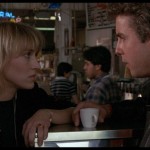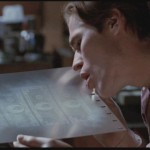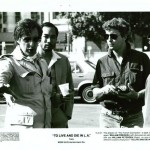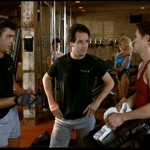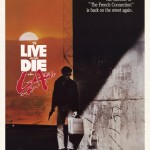To Live and Die in L.A. (1985)
Dir: William Friedkin
Stars: William Petersen, Willem Dafoe, John Pankow and John Turturro
Let’s start with a quick question: what’s the difference between the Bond film “Casino Royale” (2006) and “Moonraker” aside from the obvious difference in Daniel Craig vs. Roger Moore as Bond? I’d have to say the villain in “Casino Royale”, LeChiffre, is totally legit: he scared me, I hated him, I wanted Bond to throw LeChiffre in an incinerator after the second scene I saw him in. With “Moonraker”, I found the villain downright hilarious. He’s so hard to take seriously (and Michael Lonsdale is a GREAT actor – see Day of the Jackal if you haven’t already)!
My point with this lengthy introductory question and answer session is this: when I think about many of my favorite action adventure films, one of the common threads is this – a legit, scary, despicable villain. “To Live and Die in L.A.” suceeds in part because of the villain, with Willem Dafoe cast as Rick Masters. That this villain is not your typical serial killer, master thief or drug dealer also helps – his crime is counterfeiting. There is a lengthy, involved scene in Act 1 which establishes how Masters goes about making fake $20 bills, false $50s and clever $100s! Right away you feel like you’re learning something about criminal life – and then Masters drives away in his Ferrari GTO. That bastard. Now I REALLY despise him.
Perhaps if I describe the story as it relates to one of my favorite edits of all time, it’ll help sell this title to you. Let me do my best to set this up. There is an important scene in Act 1 with William Petersen’s hot shot Secret Service Agent, Richard Chance, “free basing” (that’s bungee jumping to us – remember, this was the ’80s) off of a bridge in Long Beach. He loves it: and the scene helps us understand that if Chance isn’t going 110 miles per hour with his job, he’s doing it on his own. This “free basing” scene is important for later, when Chance decides he’s fed up with Secret Service bureaucracy. It seems the monetary limit for front money that an agent can request for an undercover assignment is $10,000. Rick Masters knows this, so he always asks for an upfront amount in the $30,000 range because he knows an undercover agent will never have that amount! Pretty great writing there, by the way… Regardless, Chance doesn’t get an approval for the ten large – so, he decides to STEAL $50,000 from another street hoodlum that a snitch of his tells him is coming to town from San Francisco! Confused? Don’t worry about it – watch the movie!
I’m getting to the edit – bear with me. Chance drags his partner, John Vukovich, along with him to snag the $50K from this San Francisco criminal. They steal him away from the train station and drive away only to park under a bridge (hence the poster for the film): they’re in the midst of snatching the cash from this hoodlum when a rifleman shoots at them! In the midst of the shots, Vukovich shoots the criminal in the back on accident – ruh roh… The rifleman shoots again, and we begin one of the top ten chase scenes of all time – I’m not exaggerating. See the film and tell me which ones out-rank it…
And here’s where the edit occurs (thanks for bearing with)! They’re driving in the catacombs of downtown Los Angeles at high speed, pursued by fellows brandishing M-16s. The film cuts to Vukovich, seated in the back, stressed out beyond belief because all he can think about is this: there’s a quick cut to the San Francisco criminal going down, shot to death. We cut back to Vukovich who’s just cringing in agony – he had no intention of killing anyone today. Now, we cut to Chance, driving the sedan at 110 mph (or so it seems)… he looks calm, collected, soothed almost. And here we cut to him “free basing” off of the Long Beach bridge in the first act. This adrenaline rush, this is EXACTLY what he got out of bed to do today. These edits, combined with the effective storyline, make for very rich cinematic storytelling indeed.
There are other real strenghts to “Die in L.A.”, like the fight scenes in this movie – and they are BELIEVABLE. In other posts, I’ve mentioned movie fights that aren’t so believable, like the quintessential Van Damme movies in which he’s so furious with the villain that, despite the villain striking him with a metal rod or a bat repeatedly, he can still fight back and take revenge on the villain: “To Live and Die in L.A.” is not that film. There’s a scene in which Chance is escorting a convict to visit a relative of the con’s in a hospital: to be brief, the con distracts Chance, hits him several times and is gone. Now, Chance is a great hero, physically strong and generally very sharp, believe me: but part of this movie’s strength is that these scenes involving hand to hand combat are presented in extreme realism. Chance really, really wants to do a great job: but anyone hit in the right places in the right order is going down – even Chance!
The final thing I’ll leave you with regarding this exciting ’80s title is how it keeps you on your toes down to the last shot. I found the ending of this film to be 100% unexpected. Characters you think are essential to the story end up being minor. The music – that damned MUSIC – by Wang Chung no less is now classic ’80s in its style, but even so, it helps drive the story. I use that term, “firing on all cylinders” a bunch, and I can say with confidence this title definitely deserves that description: I really hope you check this one out on Netflix. And let me say this to you “Heat” fans out there – if you haven’t seen this one, shame on you… I heard another blogger put it very eloquently that this title is essentially Heat’s older brother.


